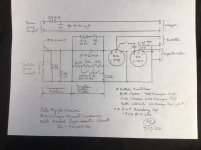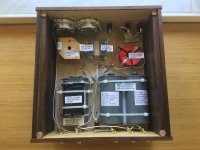Hey All,
I am recently was able to pick up a pair of 8ohm Onken 5000T Espirit supertweeters and wanted to try them in my A7 system. However, my system is a 16ohm system running a Hiraga style crossover w/ supertweeter circuit from Pete Riggle (circuit design attached). Will it pose any issues for me to simply swap out my current 16ohm supertweeter for the 8ohm Onken?
As per Pete's design, there are 2 L-pads that control the relative levels of the drivers (woofer-tweeter, tweeter-supertweeter). My thought was that if there were any level issues due to the mismatching impedance, I could adjust accordingly using the L-pads. Am I mistaken?
If I am making any major mistakes or incorrect assumptions, please let me know!
I am recently was able to pick up a pair of 8ohm Onken 5000T Espirit supertweeters and wanted to try them in my A7 system. However, my system is a 16ohm system running a Hiraga style crossover w/ supertweeter circuit from Pete Riggle (circuit design attached). Will it pose any issues for me to simply swap out my current 16ohm supertweeter for the 8ohm Onken?
As per Pete's design, there are 2 L-pads that control the relative levels of the drivers (woofer-tweeter, tweeter-supertweeter). My thought was that if there were any level issues due to the mismatching impedance, I could adjust accordingly using the L-pads. Am I mistaken?
If I am making any major mistakes or incorrect assumptions, please let me know!
Attachments
For reference, the schematic attached above was a base schematic from Pete's website - I believe he had originally made some adjustments for my specific unit to accommodate my 16ohm drivers (as such, the schematic may not be totally accurate to my unit). I have attached another image of my unit itself for reference.
Also, the Onken has a lower sensitivity than the 802D tweeters I am using - I have heard this may also pose an issue?
My current drivers:
BMS 4540ND 16 Ohm (114db sensitivity)
Altec 802D 16 Ohm (111db sens)
Altec 416A 16 Ohm (99db sens)
New Driver:
Onken OS-5000T 8 Ohm (105db sens)
Also, the Onken has a lower sensitivity than the 802D tweeters I am using - I have heard this may also pose an issue?
My current drivers:
BMS 4540ND 16 Ohm (114db sensitivity)
Altec 802D 16 Ohm (111db sens)
Altec 416A 16 Ohm (99db sens)
New Driver:
Onken OS-5000T 8 Ohm (105db sens)
Attachments
Being 8Ω, it will present less resistance so more current flow and SPL, so if less sensitive, it's not a matter.
The values of C and L ( I suppose a 2nd order at least) will vary accordingly: C will double, L...I dunno?!
The values of C and L ( I suppose a 2nd order at least) will vary accordingly: C will double, L...I dunno?!
Changing the load impedance on a passive filter will change the filter characteristics. So if the filter was designed for 16 Ω you'll get a different response with an 8 Ω speaker.
Tom
Tom
Changing the load impedance on a passive filter will change the filter characteristics. So if the filter was designed for 16 Ω you'll get a different response with an 8 Ω speaker.
Is it just a matter of character/response change? Should I expect the output levels to be unbalanced? Any risk of damage?
I happen to have an Altec 288C (24Ω) as well. Would there be any reason to pair this with the 8Ω Onken so that the combined tweeter + supertweeter would be (8Ω + 24Ω vs 16Ω + 16Ω)? Or is that just exacerbating the issue?
Last edited:
Mmmh, looking at the pic I see everything is labeled: good!
So there's a 1μF cap with "ST" which is super tweeter, in series after the HP filter.
So there's a 1μF cap with "ST" which is super tweeter, in series after the HP filter.
It won't cause damage. You just won't get the frequency response that you expect.
With a 24 Ω driver you could add a fixed resistor in parallel to bring it down to 16 Ω. You'd need (24*16)/(24-16) = 48 Ω in parallel. 47 Ω is a standard value.
Tom
With a 24 Ω driver you could add a fixed resistor in parallel to bring it down to 16 Ω. You'd need (24*16)/(24-16) = 48 Ω in parallel. 47 Ω is a standard value.
Tom
Thanks Tom. I may not have been clear about adding the 24Ω driver but my thought was to combine it with the 8ohm supertweeter in place of the current 16Ω tweeter and 16Ω supertweeter (so the combination would be 8Ω + 24Ω vs 16Ω + 16Ω). This is just as an alternative - my end goal still being finding a way to properly integrate the 8Ω supertweeter into the system.
Is that a terrible idea?
Is that a terrible idea?
The impedance of the supertweeter will be influenced and may be dominated by the Lpad, depending on it's setting, forcing it to look like 8 ohms in any case so you may not be making the big change it seemed. Even if it didn't the impedance of the tweeter near it's upper response is less affected by the supertweeter due to it being covered by the 2u2 capacitor. The impedance of the supertweeter is less affected by the tweeter since it's impedance rises toward the top unless dominated by the other Lpad.
When you adjust the crossover for the new driver, it's not only the crossover frequency but the level of the new supertweeter that can be different. Some adjustability will be with the Lpad, though that may be limited and it will also cause minor response variations which could lead you to want to keep it in one position but still want to change the level.
Fortunately with the way this kind of supertweeter is crossed, both can be compensated for by the same action. Adjusting the value of capacitance. Bigger if you want more, smaller if you want less. Try swapping the polarity. Only be concerned if the capacitor becomes too large.
When you adjust the crossover for the new driver, it's not only the crossover frequency but the level of the new supertweeter that can be different. Some adjustability will be with the Lpad, though that may be limited and it will also cause minor response variations which could lead you to want to keep it in one position but still want to change the level.
Fortunately with the way this kind of supertweeter is crossed, both can be compensated for by the same action. Adjusting the value of capacitance. Bigger if you want more, smaller if you want less. Try swapping the polarity. Only be concerned if the capacitor becomes too large.
- Home
- Design & Build
- Electronic Design
- Mismatching Speaker Impedance

